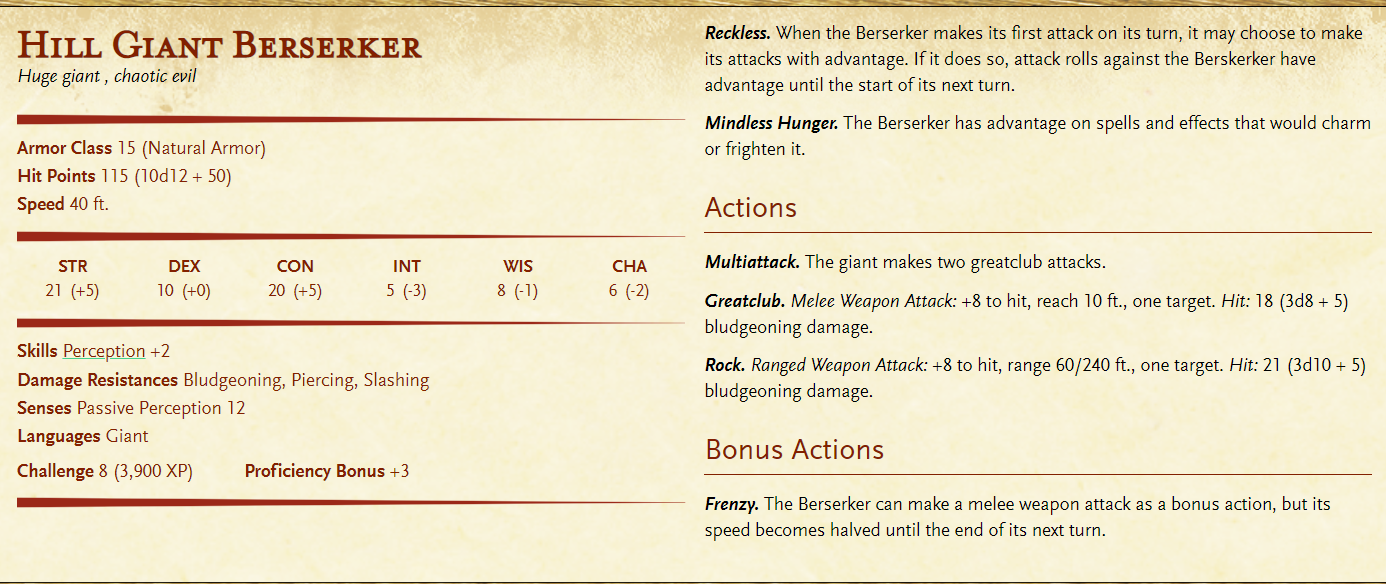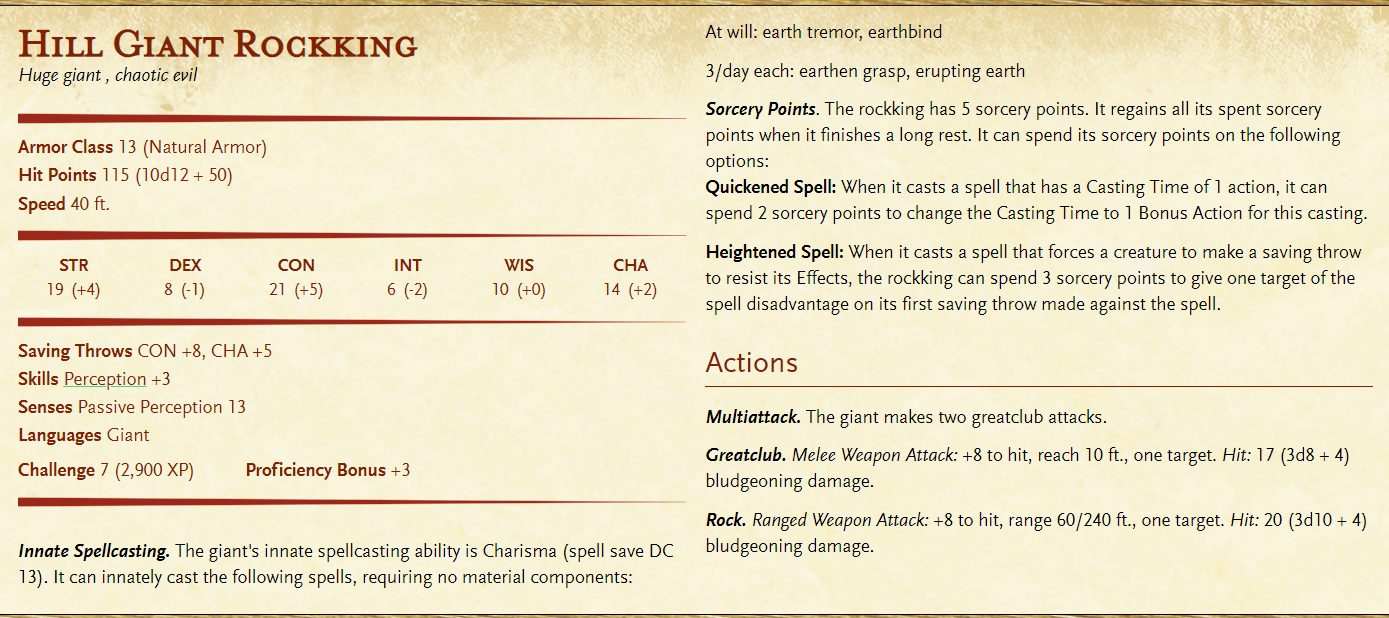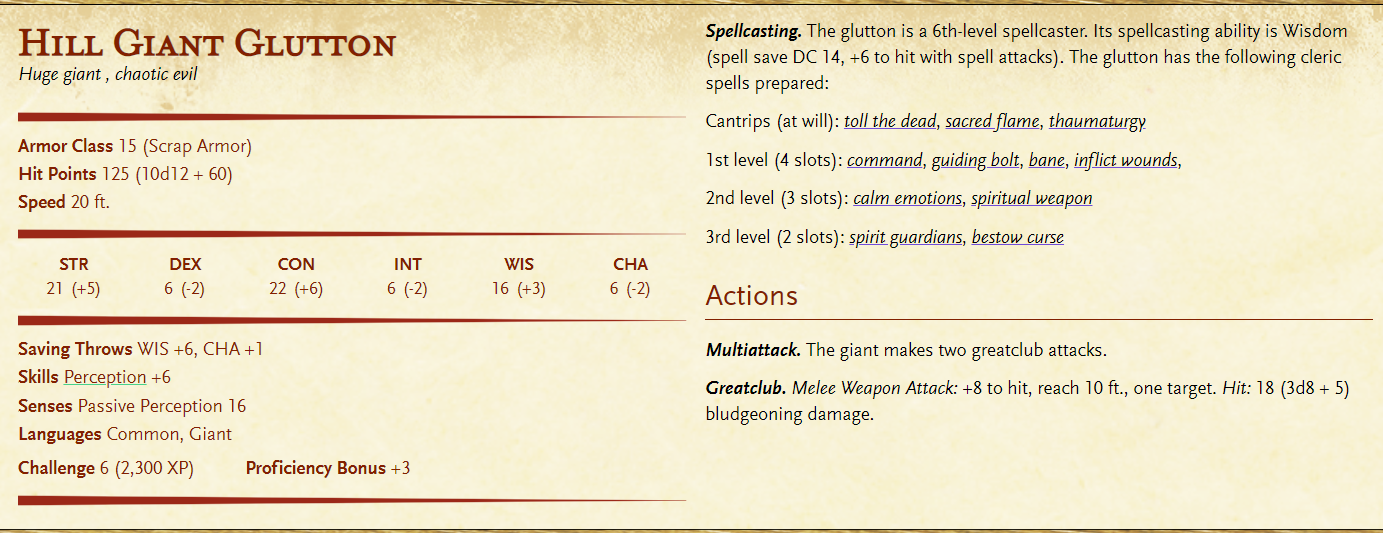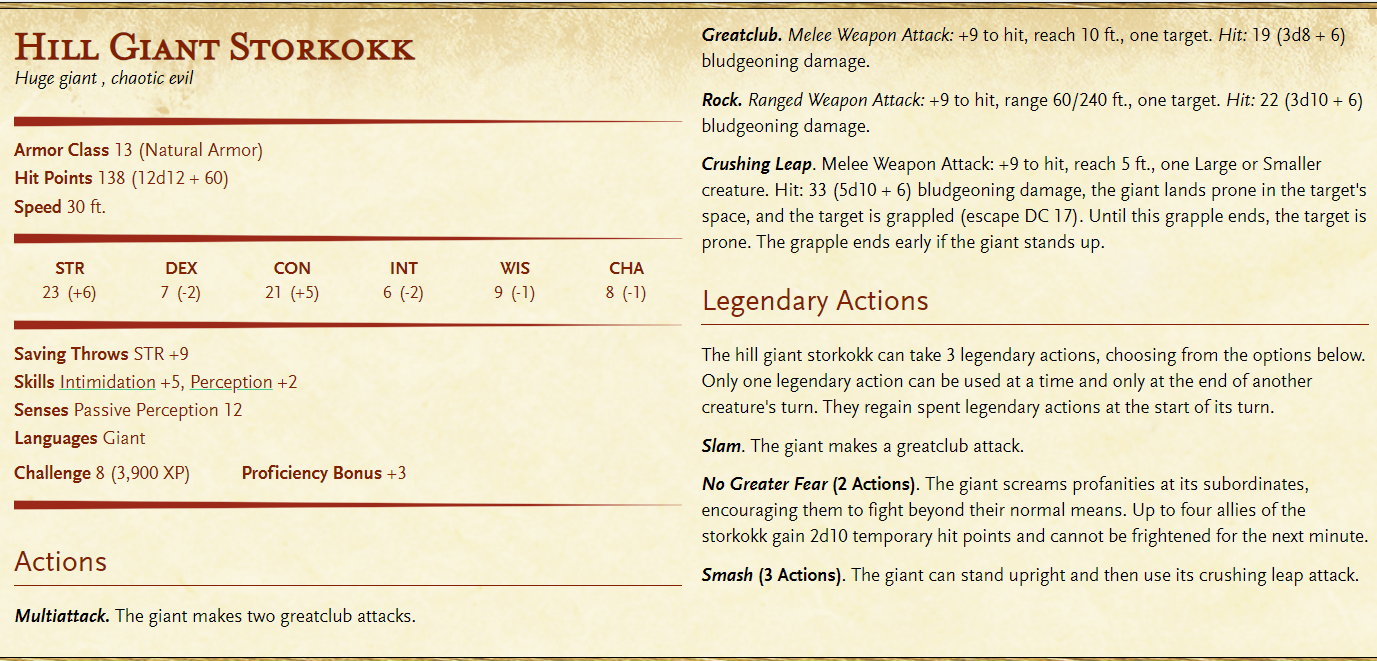Hill Giants: The Big, Dumb, Younger Brothers
Giants are a classic adversary in Dungeons and Dragons, and they continue to be featured prominently in Fifth Edition. Whether it is the thundering roar of a hungry hill giant, the Olympian-esque hurl of a boulder from a disturbed stone giant, or the sharp *crack* of a streaking bolt of lightning from a towering storm giant, these creatures are a powerful force to be reckoned with. Despite their place of high esteem in D&D lore (one of the first officially published adventures in 5e revolved around the giants) there is a pitiful lack of variety in these deadly, but mechanically bland, foes.
Giants adhere to a strict social structure called the ordning. Essentially, each giant type occupies a social position in relation to each other type. Then within each type, status is broken down further by considering the strength, size, and role of each giant. Despite the cookiecutter statblocks in the MM, no two giants are equal within the ordning. Those distinctions are what we want to capture in this series.
Over the next few weeks we are going to examine each of the “true giant” types and create a few varieties to pair with the traditional, base examples given in the Monster Manual. In each article, we will:
Discuss the key features and tendencies of that giant type.
Identify what possible roles/functions are missing.
Create several new statblocks for variant giants of that type.
First up: Hill Giants.
Hill Giants, Basically
Hill giants find themselves near the bottom of the ordning, only ranking above the “giant kin” (ettins, ogres, etc.). While staggering in size and strength compared to a humanoid, at around 16 feet tall the average hill giant pales in comparison to the other true giants. In addition to their weaker physicality, hill giants are amongst the least intelligent sentient creatures in Fifth Edition. In short, hill giants are brutish beings that use their sheer size and strength to hunt and steal food from smaller (and therefore lesser) creatures. They are constantly looking for and consuming food in a vain attempt to grow larger and stronger than their kin.
Unsurprisingly, hill giants are found in hills and mountain valleys and build their dens in local forests, caves, or canyons. They also primitively domesticate creatures, such as dire wolves, to be used as hunting and guard dogs. Some hill giant tribes will subjugate lesser giants, like ogres, and use them for menial labor or perimeter guards. A typical hill giant lair houses an extended family consisting of between 9 and 16 hill giants.
What is Missing?
For the majority of giants in a given tribe or clan, the base hill giant statblock should work pretty well. On average, hill giants are simple brutes who hunt, scavenge, and raid. But if you want to do an adventure, side quest, or even a series of random encounters involving these heavy-hitters, that is going to get very formulaic very quickly. So what roles could we have different giants fill in this hypothetical tribe?
Elite Combatant. Hill giant tribes are largely barbaric, they hunt, fight and eat. Naturally, the best fighters are able to secure the most food, gain higher standing, and use that standing to get even more food. We can expect some sort of superior class of fighters to separate from the simplistic hunters of the tribe.
Naturally Occuring Magic. Hill giants lack the aptitude to learn magic through traditional arcane means. However, I’m imagining a bit of latent magic that was passed down, and partially lost, over many millennia stemming from Grolantor (the hill giant god) and his divine parentage. Some minor innate magic that flows through a rare few hill giants, not unlike the draconic sorcerer origin for player characters, but filled with simplified earthy themes.
Divine Magic. Hill giants worship Grolantor, the giant patron deity of the hill giants. Grolantor is known for his endless hunger and constant obsession with eating. Perhaps occasionally an exceptionally ravenous and rotund hill giant is granted Grolantor’s favor. These sightings would be even rarer than the above hill giant sorcerer and could be seen as a good omen, or a divine call to form a massive raiding party.
Leadership. In any clan or tribe numbering more than a few hill giants, one will emerge as the strongest and largest. Remember, no two giants are seen as equals. With their superior size and strength, these chieftains will never want for food and will continue to grow.
Variant Statblocks
Hill Giant Juvenile (CR 3)
I am generally of the opinion that giants should be reserved for Tier 2 (levels 5-10) play, but hill giants can be an exception to that. If you want to hit your lower level party with a tough random encounter, foreshadow a larger giant presence in the area, or build out a hill giant den, the Hill Giant Juvenile is for you! Unlike the other true giants, hill giants are likely to be found roaming the countryside looking for food without any attempt at stealth. Even young hill giants may leave the safety of their hovel to find new food sources (and thus grow larger than their fellow juveniles). These younger hill giants are just as dumb, brutish, and cruel as their older counterparts. It is not uncommon to find a small gang of younger hill giants harassing the lesser members of the tribe such as ogres or goblins that have been pressed into service.
Tactics. Throw rock. Smash with club. Repeat.
Hill Giant Berserker (CR 7)
A Berserker is the second most common type of the hill giant variants here (after the Juvenile). A typical clan of twelve to sixteen hill giants likely has at least one or two Berserkers. These giants are battle-tested and prefer raiding villages and towns over hunting for game and stealing livestock in the night. If they aren’t leading a raid, they help guard the perimeter of the den or serve as bodyguards to the Storkokk (the clan chieftain). Berserkers are slightly more constituted when compared to their standard brethren, harder to bring down in a fight, and leap into battle with reckless abandon. They will not retreat, swinging viciously at their foes until only one side remains.
Tactics. Not too much to break down here. The berserker is not really smart enough to worry about tactics or retreat and their natural resistances mean they aren’t concerned with taking damage. They pick the largest and strongest looking of their opponents and attack recklessly until someone falls. As long as there is a second enemy within 20 feet of the berserker, they will make their frenzied attack.
Hill Giant Rockking (CR 7)
The emergence of latent sorcery within a hill giant is a rare event. These Rockkings are able to innately sculpt the earth around them and use it to their advantage, even possessing the ability to ground flying creatures. The presence of a Rockking emboldens their clan, leading them to engage more dangerous foes and perform riskier raids. Their reliance on magic has made them a bit weaker than an average hill giant, but their ability to engage new sources of food lead them to be fatter and more constituted than typical. For the Rockking, this power is simply a matter of instinct. It and its allies fail to recognize this as an act of magic. Instead, they believe that the Rockking has merely become so large and strong as to have command over the ground itself (hence the term, rock king).
Tactics. In combat, a Rockking will often start by quickening earthbind (if fighting an airborne foe) or earthen grasp (to prevent its prey from escaping) and then wail on its quarry with its club. They will cast erupting earth when its foes attempt to flee or when they can get at least three targets (more than it could hit with its club attacks) within the area.
Hill Giant Glutton (CR 6)
The Hill Giant Glutton is exceedingly uncommon, only one in every ten clans can boast of having a Glutton. This particular variation of the hill giant is a creature that has eaten so much food and grown so large that they have captured the attention of their patron deity. They slowly lumber around with great struggle, a Glutton prefers to remain stationary and use its station and magical abilities to boss around the other hill giants. The ascension of a Glutton is great cause for concern for the current chieftain, the Glutton can use its magic to influence the weak minds of other hill giants and bestow terrible curses if they are disobeyed. However, if a chieftain provides enough food for a Glutton, their lazy and unambitious nature can prevent a coup. Fortunately for a given adventuring party, most of the Glutton’s authority in a clan comes from the superstitious nature of its powers rather than raw combat ability.
Tactics. The Glutton is used to easily getting their way with a display of simple magic. So naturally, they start off combat attempting to curse/scare the party by casting bane. On subsequent turns, it will approach the biggest/strongest member of the party that it can reach and upcast inflict wounds. If their magic seems ineffective, the Glutton will roar in frustration and switch to melee. While they aren’t able to effectively flee, a Glutton may bargain for its life should the fight turn against it.
Hill Giant Storkokk (CR 8)
The Stokokk is the top dog, the leader of the pack. Most decently sized clans will have a Storkokk (meaning Master-Eater in giant tongue) that has risen to the leadership post. These chieftains are the strongest and largest of the hill giants, matching the average stone giant in raw strength. A Storkokk leads through fear and intimidation. They will beat, belittle, and brutally punish those who would step out of line, or withhold food from the chieftain. A Storkokk is always attended by at least 1d4 hill giants.
Tactics. When forced into combat, a Storkokk will leap a few feet into the air and belly flop onto its opponent, both as a way to deal damage and to awe its subordinates with their incredible size. They are always on the lookout for ways to assert their size and strength, grappling and pummelling any perceived threat.
Making your own clan
If you want to use these statblocks in your home game, it might be helpful to generate your own hill giant tribe. Here are some guidelines to quickly making a clan, of course feel free to just select a number for any category that you see fit.
10% chance of a Glutton
40% chance of a Rockking
1d4 Berserkers
2d6+4 Hill Giants (4d6 if a Glutton is present. 33% of these will be juveniles.
1 Storkokk
Minions:
75% chance of 2d4 Dire Wolves
25% chance of 1d4+1 Ogres
And there you have it, five new hill giant variants for use in your own games!
Next week: Peeling back the layers of the reclusive stone giants.





